
Overview
The 2006 Honda Civic follows a futuristic and high-tech "Advanced Personal Compact" design theme that incorporates a sweeping roofline and ultra-sleek windshield angle that highlights the vehicle's one-motion profile, low and wide stance, and exceptionally aerodynamic shape. The 2006 Civic is available as either a sedan or a coupe, and each variation exhibits 100 percent unique exterior sheet metal and unique proportions such as wheelbase, overall length and height. The sedan becomes more sophisticated and upscale as the coupe becomes sportier.
A major safety innovation includes the introduction of the Advanced Compatibility Engineering™ (ACE)™ Body Structure that builds on the Civic's already class-leading reputation for safety performance. Further innovations consist of sleek aerodynamics, small wheel openings that minimize the gap between the tire and the body, and ultra-tight body panel fit. Torsional rigidity increases by 35 percent.
Body Summary
- All-new platform with longer wheelbases (106.3 in. sedan / 104.3 in. coupe)
- New exterior dimensions are 1.4 inches wider
- ACE Body Structure added for enhanced frontal collision safety between vehicles of different sizes
- Torsional rigidity increases 35 percent
- Minimal wheel opening gaps between tire and body
- Extensive use of high strength steel
- Less noise and vibration
- Unique styling for Civic Si and Civic Hybrid models differentiate model leaders
- Expanded selection of colors
- Opposable windshield wipers
- Composite and zero evaporative emissions fuel tank (Civic Hybrid)
Styling
Each body style has its own unique character. As the performance leader for the lineup, the Civic Si and Civic Coupe convey an aggressive attitude that speaks to the performance potential underneath. The steeply raked windshield creates a 21.9-degree angle that is even sleeker than the 23.9-degree angle in the Acura NSX supercar. The long trunk deck, with its frontward sloping bumper, accents the forward motion conveyed by the overall vehicle shape. A muscular lower body with proportionally short front and rear overhangs express a powerful stance and a low center of gravity.
The Civic Hybrid and Civic Sedan meld high technology with a futuristic, sporty and sophisticated style for an ultra-modern, 21st century presence. Its monoform design with a long wheelbase and short overhangs emphasize strength and agility.
Dimensions
Compared to its predecessor, the 2006 Civic Sedan has grown 1.4 inches in overall length (176.7 inches) and 1.5 inches in width (69.0 inches). Its 106.3-inch wheelbase is 3.2 inches longer, while the rear overhang is 3.1 inches shorter and the front overhang is 1.8 inches longer. Height has been reduced by 0.2 inches. The front track is 1.1 inches wider (59.0 inches) and the rear track is 2.2 inches wider (60.1). Vehicle weight has increased by approximately 4 percent on each trim level - a relatively small gain considering the addition of extensive standard safety equipment, new features and greatly increased bending and torsional rigidity.
The 2006 Civic Coupe has been reduced 0.6 inches in overall length (174.8 inches) compared to the 2005 model, and is now 1.4 inches wider in width (68.9 inches). Its coupe-exclusive 104.3-inch wheelbase is 1.2 inches longer, while the front and rear overhang lengths remain unchanged. Overall height has been reduced by 3.2 inches. The front track is 1.1 inches wider (59.0 inches) and the rear track is 2.1 inches wider (60.1). Like the sedan, vehicle weight has increased by approximately 4 percent on each trim level.
Next Generation Global Compact Platform
The Civic is built on an all-new version of Honda's Global Compact Platform. The solid unit body of the Civic was designed from the outset to define a new standard for torsional and bending rigidity in the compact segment. The new Global Compact Platform implements advanced body construction technologies for enhanced safety, better rigidity, improved ride comfort and a quieter cabin. Advanced new structural engineering and manufacturing methods utilizing 50 percent high-strength steel, of which 38 percent is high-grade (590MPa), results in a torsional rigidity increase of 36 percent, even as the wheelbase and width have grown. The body structure, including the important mid-floor cross members and floor gussets, are also made of high-grade high-strength steel. The longer wheelbase serves to increase its stability during straight-line running, as well as when braking and turning.
The Civic features a 4-wheel independent suspension system that, for 2006, has been completely reengineered to provide even more agile handling and refined ride comfort. Up front, the Civic features a compact Control-Link MacPherson Strut suspension for outstanding handling, ride and packaging. The Control-Link MacPherson Strut design delivers quick, responsive handling by helping to maximize each front tire's contact with the road throughout the range of suspension travel. In the rear, the Civic is equipped with a double-wishbone multi-link suspension that helps provide a smooth ride, excellent handling, and good cargo space. (See the Chassis section for more details on the suspension.)
 ACE Body Structure and Related Safety Construction
ACE Body Structure and Related Safety Construction
Body construction now includes Honda's Advanced Compatibility Engineering™ (ACE)™ Body Structure that enhances frontal collision energy management through a network of load bearing structures in the front of the vehicle. This newly developed front-end frame structure (similar to the all-new 2005 Honda Odyssey ACE Body Structure) incorporates new upper and lower frame members to significantly enhance energy dispersion in a frontal collision throughout the upper and lower load bearing channels in the body. The ACE concept differs from traditional crash designs that guide a high percentage of collision force through a vehicle's two lower channels in a collision. The ACE design with its polygonal front structure helps reduce the potential for misalignment with the frame of the opposing vehicle. Taken together, these features are designed to increase compatibility between vehicles of different size categories for enhanced occupant protection in the event of a collision.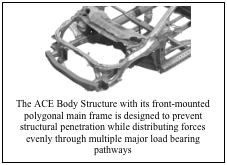 The Civic's ACE body structure is configured for high energy absorption. In the event of a frontal collision, the body structure with its front-mounted polygonal main frame is designed to prevent structural penetration while distributing forces evenly through multiple major load bearing pathways - and away from the passenger compartment. For comparison, a conventional body structure generally concentrates the loads from a collision through two pathways running longitudinally through the lower portion of the frame. In the ACE body structure for example, frontal impact force can be distributed from the front of the vehicle through the side sill, floor frame and A-pillar in order to reduce the cabin deformation.
The Civic's ACE body structure is configured for high energy absorption. In the event of a frontal collision, the body structure with its front-mounted polygonal main frame is designed to prevent structural penetration while distributing forces evenly through multiple major load bearing pathways - and away from the passenger compartment. For comparison, a conventional body structure generally concentrates the loads from a collision through two pathways running longitudinally through the lower portion of the frame. In the ACE body structure for example, frontal impact force can be distributed from the front of the vehicle through the side sill, floor frame and A-pillar in order to reduce the cabin deformation.
The bottom line is that the ACE body structure enhances energy distribution during a collision because impact forces can be distributed through more vehicle mass and away from the passenger compartment.
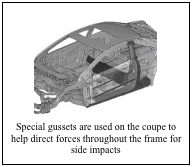 For side impacts, all models now incorporate high-grade, high-strength steel body side frame structure. Additionally, coupe models apply special gussets used to further help direct forces throughout the frame for side impacts.
For side impacts, all models now incorporate high-grade, high-strength steel body side frame structure. Additionally, coupe models apply special gussets used to further help direct forces throughout the frame for side impacts.
Door Construction
For safety, all Civic doors feature side impact protection beams. For quality, the doors are built on a robust structure that provides a solid feel and sound when closing. The door latches themselves are carefully engineered to latch securely with a light closing pressure, and to emit a quality sound. Honda engineers also designed a special "bumping door seal" that purposefully transmits a certain low-frequency vibration to the door itself. This desirable vibration is heard as a substantial sound as the door closes that confirms the impression of substance and quality.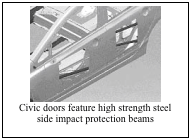 Additionally, the Civic's front doors use triple-stage stopper construction for ease of ingress/egress in tight parking situations.
Additionally, the Civic's front doors use triple-stage stopper construction for ease of ingress/egress in tight parking situations.
Pedestrian Safety
Honda's commitment to safety extends to pedestrians as well as vehicle occupants. To help reduce pedestrian injuries in the event of a collision, the Civic's hood and fender areas are designed to deform if contacted by an adult or child pedestrian. Energy-absorbing collapsible hood supports, wiper arm pivots and fender mounts are designed to allow substantial deformation in an impact.
Front Subframe
To maximize gains derived from its stronger body, the front subframe of the new Civic has structural enhancements that improve ride and handling characteristics, while reducing noise and vibration. The front subframe is a completely new design with hydro-formed elements that substantially increase both strength and rigidity. Hydro-forming is the state-of-the-art method of creating complex shapes from steel. To make Civic's major subframe components, hydraulic water pressure forces the steel tube into rigid dies (molds) under tremendous pressure. The result is a precisely made part that is stronger where necessary and precisely the right size and shape. The subframe is attached to the Civic's body using special rubber floating mounts that minimize the level of road and engine noise and vibration transferred to the passenger compartment. However, the Civic Si utilizes stamped and welded components for the subframe due to its unique engine and transmission.
Aerodynamics
The Civic conveys an aerodynamic presence on the surface, but many aerodynamic improvements exist in areas that may not be obvious. All models feature a chin spoiler and multiple undercovers that reduce air turbulence near the engine, rear wheels and rear bumper.
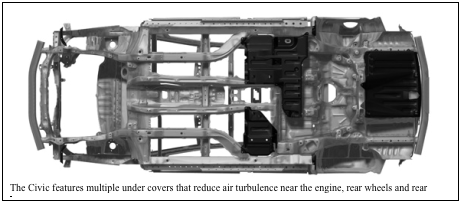
The Civic Si manages the airflow even further and features a rear wing spoiler that creates downforce at high speeds, along with a brake cooling strake (a small fin ahead of the front wheel) that directs air across the brake rotor like a dedicated brake duct.
The Civic Hybrid and Civic Coupe models use a lip spoiler on the trunk that cleans up the airflow behind the vehicle and it creates downforce at high speeds. The Civic Hybrid also has additional engine and front floor undercovers for even cleaner aerodynamics. In order to accommodate the steeply raked windshield and its significant surface area, opposable windshield wipers are used that cover more surface area than typical wipers and the blade bodies have a flat design that makes air flow push the wiper blades firmly against the glass.
The Civic manages airflow for an approximate 5 percent improvement in coefficient of drag (Cd). Items such as the A pillar, side mirrors, wiper layout and the use of underfloor pans have all been designed to minimize air turbulence. These designs result in enhanced fuel economy and less wind noise. Other measures contributing to reduce wind noise levels include dramatically reducing the width of body seams, mounting glass flush with the surrounding body panels, and using double seals around all doors.
Rear Flat Floor
An integral part of all Civic models is its unique rear flat floor, and the Civic retains this feature. The challenge presented by a rear flat floor is reduced rigidity (because a flat sheet flexes more readily than a formed one). To overcome this tendency, the Civic has a "tunnel side frame" with a large, flat cross section instead of a typical tunnel structure. This improves torsional rigidity and makes the body stronger.
Spacious Trunk
The trunk of the sedan and coupe is big enough to accommodate a variety of modules including four golf bags, a 19-inch mountain bike (with the rear seat folded), a 3-piece luggage set, a full size wheel chair or 72-quart cooler. The cargo volume of the Civic Sedan measures 12.0 cubic feet, while the cargo volume of the coupe is 11.5 cubic feet with smart dimensions that make the most of the space, as evidenced by the key modules that will fit.
The trunk now features a rigid and fully hinged spare tire cover with a laminated mat surface, and a molded tire spacer with integrated storage for small items. Additionally, Civic Hybrid and Sedan EX models feature a trunk lining and covers on the trunk hinges.
Tight Tolerances
Honda vehicles have long been synonymous with outstanding fit and finish. This attention to detail is evident in the increased body panel fit accuracy that produces significant reductions in the sizes of gaps between body panels and interior components. The entire Civic lineup features what is known as a "zero" gap for the front and rear bumpers, or less than a single millimeter. This gives the bumpers a more integrated appearance, yet keeps collision costs to a minimum by isolating various body components so fewer components require replacing in the event of an accident.
Noise and Vibration Dampening
Significant effort to reduce interior noise and vibration has been put into the Civic platform. The Civic offers low levels of passenger compartment engine noise during acceleration. This is due in part to the high levels of torsional rigidity of the Civic platform and the application of high-energy noise and vibration absorption materials.
The Civic utilizes "melt sheets" on the floor, around the tunnel, and around the tire pan in the trunk. This asphalt insulation material is literally "melted" into place on the floor to ensure a precise fit and to help reduce interior noise.
- Rubber-backed floor mat insulators help stop road noise before it reaches the interior.
- A dashboard insulator reduces engine noise in the interior.
- Urethane foam is applied inside the pillars to fill the gaps and reduce the amount of noise transmitted to the interior.
- The doors now have two seals for reduced noise intrusion.
Exterior Lighting
The Civic headlamp design uses sharp and wide dual halogen lamps for front-of-vehicle illumination. The lamp assemblies feature a clear one piece outer lens that wraps around the vehicle's front corners with the turn signals housed inside. The round inboard lamps function as the newly added daytime running lamps and also provide high beam illumination, while the outboard lamps are for normal driving. The halogen headlights offer class-leading performance, casting a beam wide and far, while also providing brighter illumination of objects in closer proximity, than any other Civic before it. The Civic Si incorporates distinctive amber inner headlight rings, while the Civic Hybrid has a clear turn signal lens (illumination is amber), instead of the amber lens found on other models.
The sedan's "drop focus" rear taillights feature a reflective inner-cube design as the background pattern during illumination. The lenses are solid red for brake and running lights, with a clear outer lens for turn signals (illumination is red for sedan, and amber for coupe). A large back-up-lamp reflector provides extra illumination when in reverse. The coupe features uniquely shaped taillights that accent the "forward motion" slant to the rear trunk shape. Civic Hybrid models also feature side marker turn signal lamps integrated into the side-view mirrors.
Opposable Windshield Wipers
The Civic windshield wiper system uses innovative outboard-mounted opposable wiper design that maximizes blade coverage and visibility on the vast expanse of windshield created by the sleekly angled vehicle profile. Each wiper uses a flat blade design for improved wiping capabilities in rain and freezing weather, and the arm shape is aerodynamically configured to provide good blade downforce at high speeds. The driver's blade measures 25.6 inches in length, much longer than the usual blade, while the passenger's blade measures 22.6 inches in length. The superior flat blade construction features long lasting durability, yet is also easy to service with a rubber insert that requires no special tools or high cost items to replace. Another benefit includes a clean appearance from inside the vehicle with the wiper profile neatly conforming to the base of the windshield. Civic Si, Hybrid and EX models feature variable intermittent, low and high speed wiper action, while Civic DX and LX models provide intermittent, low speed and high speed operation.
Civic Si Unique Body Features
The Civic Si has many unique exterior features - some subtle, others not so subtle. The differences from the other coupe models include:
- Front spoiler
- Sports grille with Si emblem
- Trunk-mounted wing spoiler
- Unique wheel design
- Oval chrome exhaust tip
- Internal amber headlight rings
- Rear Si emblem
- DOHC i-VTEC decal on the rocker panels
- Larger "H" emblem on the trunk
Civic Hybrid Unique Body Features
The Civic Hybrid incorporates unique body features, they are:
- Exclusive lip spoiler on trunk
- Unique aerodynamic wheel design
- Roof mounted micro antenna
- Side mirror turn signal indicators
- Hybrid emblem on trunk
- AT-PZEV window sticker (applicable to certain states)
- Clear front turn signal (instead of amber)
Civic Sedan, Coupe and Si Fuel Tank
The Civic is equipped with a six-layer resin fuel tank that offers reduced weight, increased capacity, and reduced emissions. Capacity is maximized to 13.4 gallons because the resin tank can be molded to fit around various components. For 2006, the shape of the fuel tank was optimized to reduce fuel evaporation. This reduction lowered evaporative emissions by 75 percent, helping the Civic to achieve a LEV-2 rating. The Civic also incorporates a returnless fuel supply system that helps reduce vapor generation.
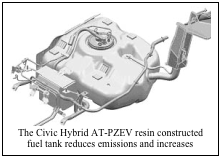 Civic Hybrid: Composite Zero Evaporative Emissions Fuel Tank
Civic Hybrid: Composite Zero Evaporative Emissions Fuel Tank
A critical component to complying with Advanced Technology Partial Zero Emission Vehicle (AT-PZEV) regulations involves having a zero evaporative emissions fuel tank. Traditionally, those tanks have used steel construction instead of composite construction because some extremely small amounts of fuel vapor (hydro carbon permeation) can escape from the polyethylene resin composite construction.
Honda has pioneered a new six-layer polyethylene composite design that provides zero evaporative emissions performance while also decreasing weight and increasing fuel capacity. Compared to the previous PZEV steel gasoline tank, the new composite gas tank weighs approximately 8 pounds less and holds about a half-gallon more fuel (12.3 gallons total).
Available Colors
The Civic is available in thirteen exterior colors and four interior colors. Some of the colors are exclusive to a particular model such as the Si or Hybrid, and the interior colors are typically exclusive to a particular color and/or trim level.
Exterior Colors
Taffeta White
Alabaster Silver Metallic (new)
Galaxy Silver Metallic (new)
Nighthawk Black Pearl
Fiji Blue Pearl (Si only)
Royal Blue Pearl (new)
Atomic Blue Metallic (new)
Habanero Red Pearl (new - Si only)
Opal Silver Blue Metallic (Hybrid only)
Magnetic Pearl (New - Hybrid only)
Rallye Red
Shoreline Mist Metallic
Tango Red Pearl
Interior Colors
Black
Gray
Beige
Blue (Hybrid Only)